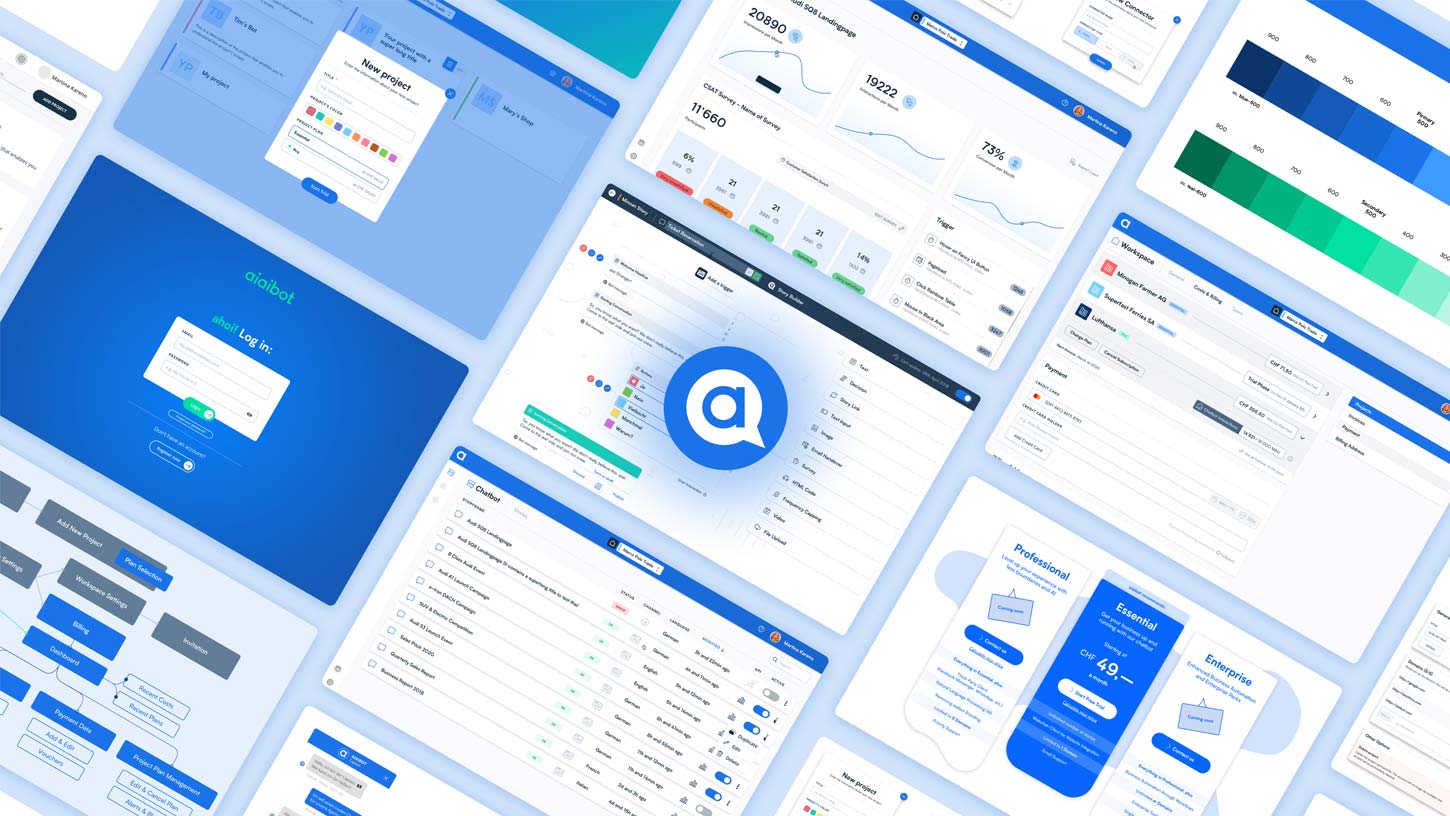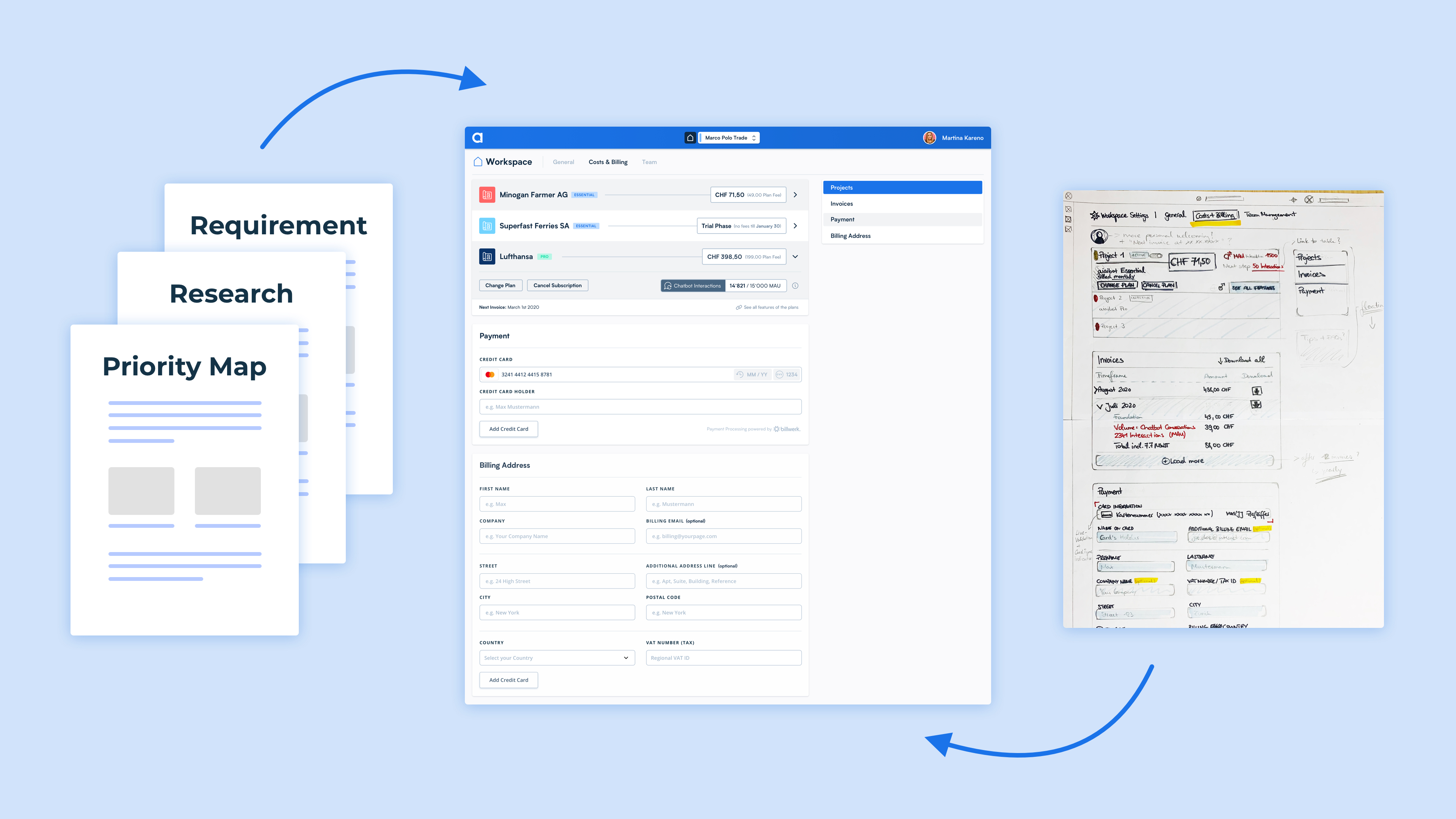Product
aiaibot
Provide people a simple and efficient way to explore the world of conversational technology. This was our goal while aiaibot was founded. Discover in this case study which value design had for our chatbot platform.
Provide people a simple and efficient way to explore the world of conversational technology. This was our goal while aiaibot was founded. Discover in this case study which value design had for our chatbot platform.

Chatbots are assisting multiple user journeys on digital channels. Especially the 24/7 availability and the fast response of common questions makes them a great additional channel for your communication.
But besides different positive expectations, chatbots still did not establish on the market. That makes it even more exciting to find out what the real needs and desires of people using digital touchpoints are. With aiaibot, we entered into this challenge.

Joining aiaibot, we were confronted with the problem of the over-saturation of webpages. Especially digital offers of small and middle-sized companies evolved to complex and information-dense touchpoints for people. While conversion optimization could become expensive and complicate to maintain, vendors and content delivery are searching for a communication channel to grow attention and to interact humanly with their target group.
On the other hand, people want to find answers for different requests. There are, for example, service-related questions, often raised on support platforms or knowledge pages. Another example is the fast processing of sales procedures, shortening the complicated customer journey of different goods acquisitions.
Based on the experiences of our previous research team and the development of the on-premise solution lena by PIDAS, we had the chance to include their knowledge into a new mission and vision for a scalable and dynamic SaaS product: aiaibot.


So focusing on who is going to use our conversational platform and who has the given problem with a strong desire to solve it, we faced some difficulties with focusing on a particular target group.
While the conversation is something human and basically in our everyday lives, a conversational platform could be dedicated to a single group much easier. That's why we focused on the user of our software as we were developing our first Personas — reminding us that we always need to challenge the output of our software for a more significant range of people.
To validate our software experience, we decided to create three different target groups: Agency, Self-Doer, and Enterprise. Concentrating on the agencies which should help us to spread chatbots as a new communication channel for their clients should help us to reach a broad group of people to test and improve our software.

Together is better. Our Product Team at aiaibot started with 7 people developing the platform. We followed the idea of the Scrum Framework and were planning Sprints of 2 weeks. With this Agile Framework, it was easy to connect with the team members and to build innovation in a user-centered approach.
Together with Andreas Stebler, I worked hard to establish an environment of Design Thinking and User Centricity. How can we solve problems lean without losing a consistent brand experience in our software? How can we speed up development with reusable components and ready-to-go code? Questions we both loved to find answers.
In my role, I was explaining to our stakeholders the importance of User Experience Design and research-based work strategies to ensure that expensive development capacities are producing solutions that satisfy a real need. With lean research methods, it was possible to find answers for urgent problems and to design fact related interfaces.
Like in many startup teams, Andreas and I were covering similar fields in the UX and UI process to ensure stability and exchangeable resources. That's why we both developed our Design System Harbor, researched problem-solution fits, designed interfaces, and worked on a public representation of our design work.
I am also very happy that I had the honor to work with Calvino and Domenico for a few months, having the possibility to lead our creative journey and to listen to their ideas and ways to solve our problems.
People I would also like to enumerate here and to thank for the carefully teamwork are Dimitri (Product Management), Simon (Frontend Engineering) and Fero (Backend Engineering).
Design in an Agile Environment is demanding and requires different experiments to identify the right approach for your team. That's why were working hand in hand together with our CTO and Product Management to find the right fit for our product team as we learned that there are different approaches to reach our goals.
Understanding that defining this process is very individual, we started to test different methods and rhythms to enable Agile Design in our company. Recently we are working with so-called "Pre-Sprints" to do research and build the Information Architecture related to the new features, followed by an Agile Designing Phase which is iterated by Designers and Frontend Engineers jointly.
While solving problems of recent Sprints and delivering high-quality designs to our developers, we always improved our setup and Design System. Covered by the theme of the field of DesignOps, we cared much about the working conditions, toolings, and the satisfaction of each designer. Making this processes more seamless gives us time for the creative tasks of our work – something that benefits everyone.
Please have a look at our outcome in the following images.
An outcome which was only possible through a perspective of a whole, teamwork and dedication to our vision, mission and values.



We want to see chatbots on every digital touchpoint making customers happy. Becoming the world’s favourite Conversational AI Platform – easy to use, powerful & simple to integrate.